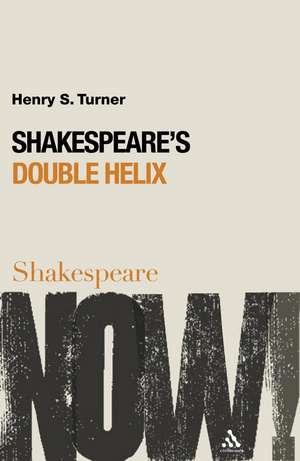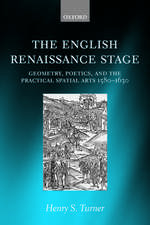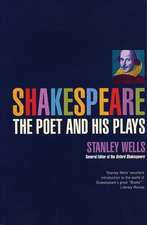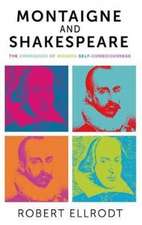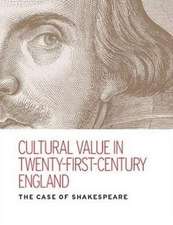Shakespeare's Double Helix: Shakespeare Now!
Autor Henry S. Turneren Limba Engleză Paperback – 19 dec 2007
| Toate formatele și edițiile | Preț | Express |
|---|---|---|
| Paperback (1) | 162.45 lei 6-8 săpt. | |
| Bloomsbury Publishing – 19 dec 2007 | 162.45 lei 6-8 săpt. | |
| Hardback (1) | 282.06 lei 6-8 săpt. | |
| Bloomsbury Publishing – 19 dec 2007 | 282.06 lei 6-8 săpt. |
Din seria Shakespeare Now!
- 9%
 Preț: 150.05 lei
Preț: 150.05 lei - 9%
 Preț: 149.61 lei
Preț: 149.61 lei - 15%
 Preț: 162.36 lei
Preț: 162.36 lei - 15%
 Preț: 162.51 lei
Preț: 162.51 lei - 10%
 Preț: 124.55 lei
Preț: 124.55 lei - 5%
 Preț: 162.82 lei
Preț: 162.82 lei - 14%
 Preț: 149.70 lei
Preț: 149.70 lei - 14%
 Preț: 162.71 lei
Preț: 162.71 lei - 9%
 Preț: 149.35 lei
Preț: 149.35 lei - 15%
 Preț: 162.10 lei
Preț: 162.10 lei - 25%
 Preț: 162.79 lei
Preț: 162.79 lei -
 Preț: 165.48 lei
Preț: 165.48 lei - 15%
 Preț: 162.36 lei
Preț: 162.36 lei - 25%
 Preț: 163.24 lei
Preț: 163.24 lei - 9%
 Preț: 149.54 lei
Preț: 149.54 lei
Preț: 162.45 lei
Preț vechi: 190.31 lei
-15% Nou
Puncte Express: 244
Preț estimativ în valută:
31.08€ • 32.54$ • 25.72£
31.08€ • 32.54$ • 25.72£
Carte tipărită la comandă
Livrare economică 05-19 aprilie
Preluare comenzi: 021 569.72.76
Specificații
ISBN-13: 9780826491206
ISBN-10: 0826491200
Pagini: 144
Dimensiuni: 129 x 198 x 11 mm
Greutate: 0.16 kg
Editura: Bloomsbury Publishing
Colecția Continuum
Seria Shakespeare Now!
Locul publicării:London, United Kingdom
ISBN-10: 0826491200
Pagini: 144
Dimensiuni: 129 x 198 x 11 mm
Greutate: 0.16 kg
Editura: Bloomsbury Publishing
Colecția Continuum
Seria Shakespeare Now!
Locul publicării:London, United Kingdom
Caracteristici
The book contributes to current interest in early science and debates about scientific, religious and creative definitions of human life.
Cuprins
General Editors' Preface
Preface
When everything seems double
Two intertwining helices
That is the true beginning of our end
Then read the names of the actors
Index
Preface
When everything seems double
Two intertwining helices
That is the true beginning of our end
Then read the names of the actors
Index
Recenzii
Mention in Today's Books/ Bookweek
Reviewed by Peter J. Smith in Times Higher Education Supplement, 2008.
"the conjoined pieces of Turner's book provide a fresh double reading of A Midsummer Night's dream. The book's imbricated left face/right face presentation makes every page mirror, echo or pre-empt themes from the opposite essay. In this year of Darwin's birth, the Globe Theatre's 2009 takes A Midsummer Night's dream on a national tour. Shakespeare Now! seems thus doubtly apt." Flux Magazine, 1 July 2009
"...both an eye-catching attempt to assert Shakespearian contemporaneity and a genuine reflection of aspects of the volume's content...has a definite novelty value in the context of Shakespearian criticism, and it is raised above the merely gimmicky here by the highly apposite image that Turner finds for his title...a very readable, clear and informative quick overview of the development of modern genetic research...there is much interesting and stimulating comment in Turner's study, and the book itself ins undeniably memorable and thought-provoking." Oxford Journals Clippings: The Year's Work in English Studies, 2009
"The ambitious project of the Shakespeare NOW series is to bridge the gap between 'scholarly thinking and a public audience' and 'public audience and scholarly thinking'. Scholars are encouraged to write in a way accessible to a general readership and readers to rise to the challenge and not be afraid of new ideas and the adventure they offer. There are other bridges the series is ambitious to cross: 'formal, political or theoretical boundaries' - history and philosophy, theory, and performance." English Vol. 58, 2009
"In Turner's text past, present and the 'posthuman future' come together and Francis Bacon, Philip Sydney, and Bottom rub shoulders playfully with Richard Dawkins, Roland Barthes, and Puck." English Vol. 58, 2009
Briefly reviewed in the Year's work in English Studies journal, vol 89, No. 1
'The Shakespeare Now! series of 'minigraphs' aims to appeal to both Shakespeare specialists and the educated public by producing 100- to 140-page texts that purportedly reduce or eliminate arcane endnotes and scholarly jargon and that address timely topics- mainly post-modern ones- in readily understandable prose.'
Reviewed by Peter J. Smith in Times Higher Education Supplement, 2008.
"the conjoined pieces of Turner's book provide a fresh double reading of A Midsummer Night's dream. The book's imbricated left face/right face presentation makes every page mirror, echo or pre-empt themes from the opposite essay. In this year of Darwin's birth, the Globe Theatre's 2009 takes A Midsummer Night's dream on a national tour. Shakespeare Now! seems thus doubtly apt." Flux Magazine, 1 July 2009
"...both an eye-catching attempt to assert Shakespearian contemporaneity and a genuine reflection of aspects of the volume's content...has a definite novelty value in the context of Shakespearian criticism, and it is raised above the merely gimmicky here by the highly apposite image that Turner finds for his title...a very readable, clear and informative quick overview of the development of modern genetic research...there is much interesting and stimulating comment in Turner's study, and the book itself ins undeniably memorable and thought-provoking." Oxford Journals Clippings: The Year's Work in English Studies, 2009
"The ambitious project of the Shakespeare NOW series is to bridge the gap between 'scholarly thinking and a public audience' and 'public audience and scholarly thinking'. Scholars are encouraged to write in a way accessible to a general readership and readers to rise to the challenge and not be afraid of new ideas and the adventure they offer. There are other bridges the series is ambitious to cross: 'formal, political or theoretical boundaries' - history and philosophy, theory, and performance." English Vol. 58, 2009
"In Turner's text past, present and the 'posthuman future' come together and Francis Bacon, Philip Sydney, and Bottom rub shoulders playfully with Richard Dawkins, Roland Barthes, and Puck." English Vol. 58, 2009
Briefly reviewed in the Year's work in English Studies journal, vol 89, No. 1
'The Shakespeare Now! series of 'minigraphs' aims to appeal to both Shakespeare specialists and the educated public by producing 100- to 140-page texts that purportedly reduce or eliminate arcane endnotes and scholarly jargon and that address timely topics- mainly post-modern ones- in readily understandable prose.'
